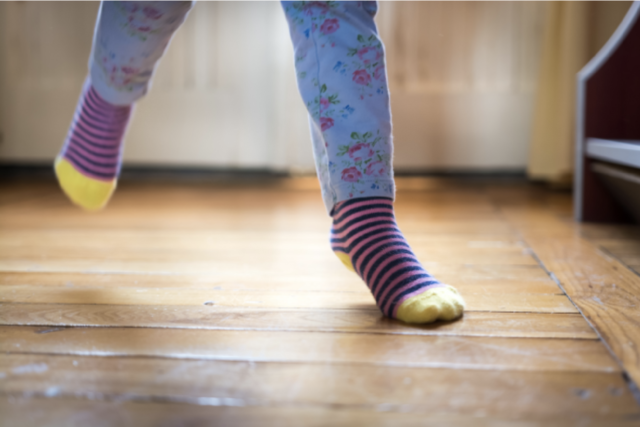Toe walking is a pattern of walking in which a child walks on the balls of their feet, with no contact between the heels and the ground. Toe walking is common in children who are learning to walk. After age 2, however, most children outgrow toe walking and begin walking with a normal heel-toe pattern (AAOS, 2022). There are a few reasons a child may toe walk beyond the age of 2, but sensory-based approaches for toe walking are important for those who demonstrate sensory-seeking behaviors/hypersensitivity on their feet.

Children who toe-walk due to hypersensitivity on their feet may avoid walking on grass, dislike being barefoot, and become upset/distressed with socks/shoes that are “too tight” or have seams. Children who are seeking vestibular or proprioceptive input by toe-walking may like to jump/crash into furniture, climb playground equipment/furniture, and like to sleep under a lot of blankets.
So how do we address toe-walking from a sensory-based perspective? If it is a hypersensitivity issue, we can address it by walking on different textured surfaces, putting feet in sensory bins, creating obstacle courses that work on static and dynamic balance, and introducing a brushing protocol to the bottom of the feet to decrease sensitivity. If a child is seeking proprioceptive input and is toe-walking to gain more input, they would often be categorized as sensory seeking. For these children, the approach is similar but also teaches them to gain proprioceptive and/or vestibular input through other means, such as pushing/pulling heavy objects, stomping their feet, completing animal walks, or wearing a weighted vest. All of these activities help to bring awareness to toe-walking and encourage them to walk with a heel strike (GG, 2022). The therapist may also recommend you get evaluated for an SMO to decrease toe walking (see our previous article on SMOs for toe walking for more information).
If your child is continuing to toe walk after the age of 2, it is highly recommended to seek out a pediatric physician to assess your child to see if a physical therapy or occupational therapy evaluation is warranted. Overall, a team approach to treating your child’s toe-walking may be the best course of action for your child to address toe-walking.
References:
AAOS. (2022, April). Toe Walking. OrthoInfo.
https://orthoinfo.aaos.org/en/diseases–conditions/toe-walking/#:~:text=Toe%20Walking,no rmal%20heel%2Dto%2Dtoe%20pattern
DPT, G. G. (2022, August 26). Physical and occupational therapy for Toe Walking. Ability Innovations.
https://abilityinnovations.com/blog/occupational-therapy-for-toe-walking
Blog by:
Mackenzie H.
(MOT, OTR/L – Occupational Therapist)
